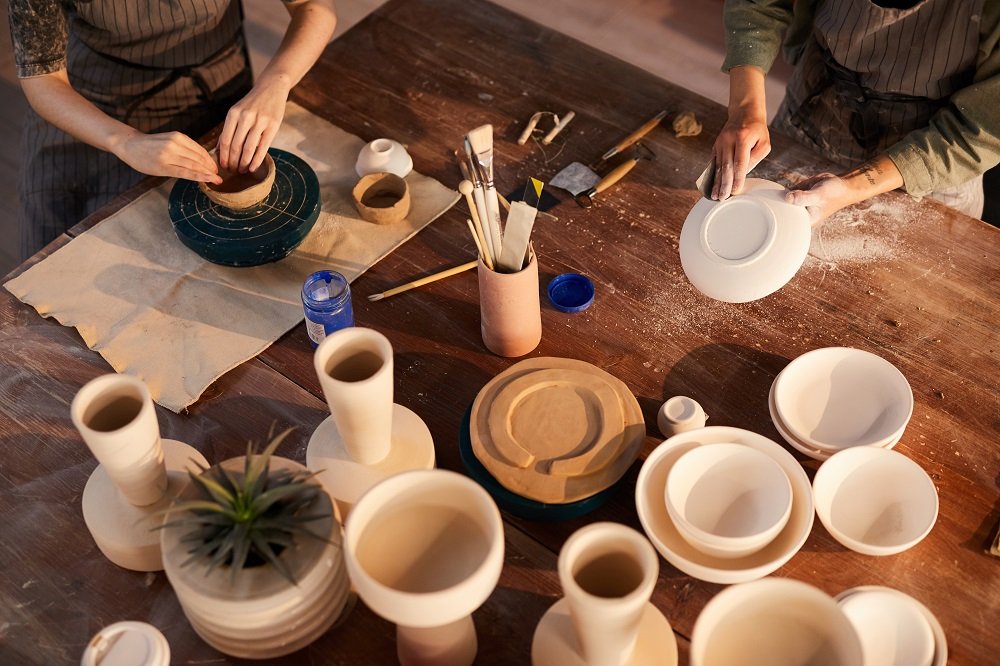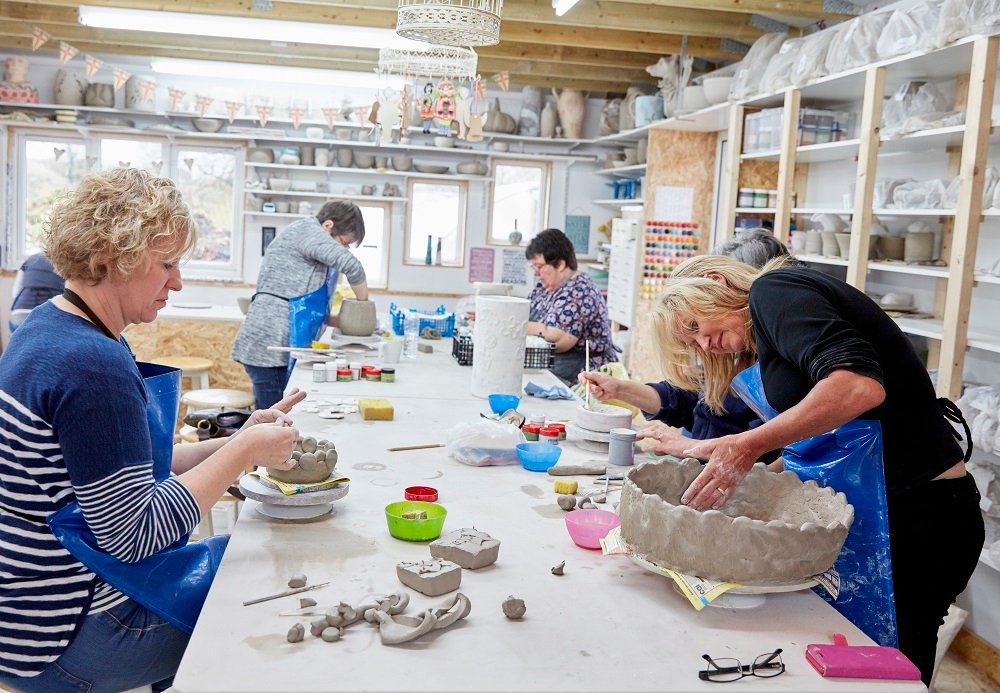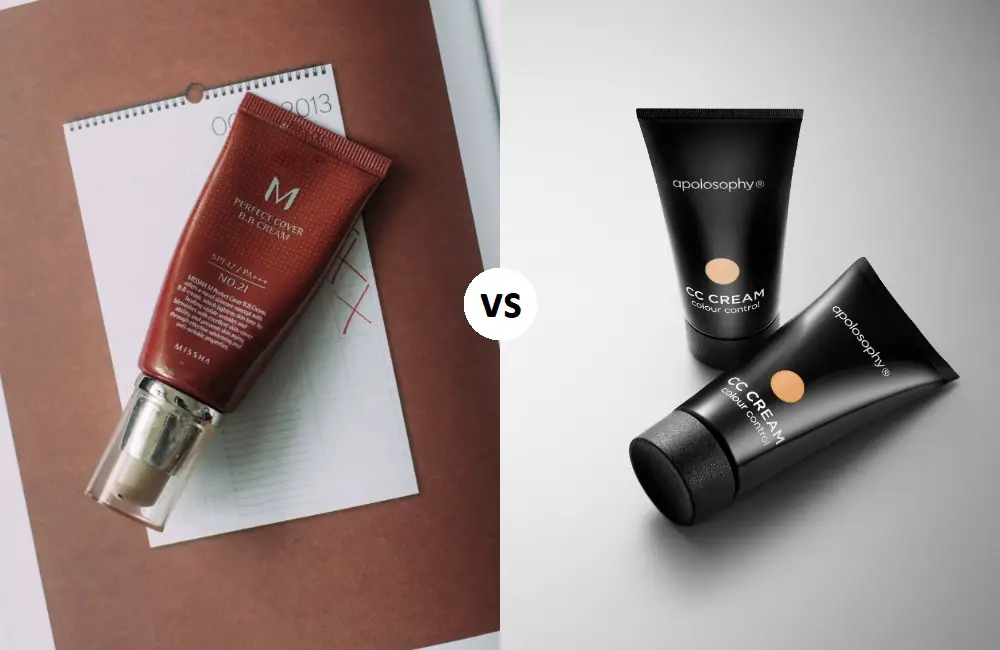The Differences Between Pottery and Ceramics
For years, both ceramics and pottery have been a significant part of social culture. From showpieces to kitchen utensils, you can get anything from these two artisanship.
Let’s face it! Sometimes, our mind gets confused in terms of identifying the exact material between ceramic and pottery; why? Because a few items appear to be ceramics, but these are actually based on pottery.
So, to make your identification a piece of cake, knowing the difference between pottery and ceramics is crucial! Be sure to keep on reading the writing from head to toe in order to know about them in detail.
Definition of Pottery

Usually, the pot or container constructed with clay is considered pottery. In this case, we’re familiar with the common term “pot,” which is used for almost every type of container form.
In a nutshell, pottery can be used to create a number of different items, including food containers, bowls, serving pots, pots for flowers, and so on.
Pottery requires “clay” as a primary material. The item is manufactured by forming different kinds of sizes and shapes with the assistance of clay. Afterward, heating them up becomes necessary in a particular pit or kiln, ensuring permanent changes.
Both pot and pottery stem from an old English “potian” meaning “to push something.” In the system of manufacturing pottery, the craftsman gently pushes when he/she throws clay onto the particular wheel, thus the name speaks for itself!
Types of Pottery
You’ll find three different types of pottery in general, including:
- Porcelain
Hands down, it’s the hardest and strongest type of pottery fired at a maximum temperature of around 1200°C to 1500°C. Besides, it’s also known as “fine china.”
Speaking of the type, this is the oldest one of white ceramics constructed by grinding up a little granite, glass, feldspar minerals with white clay (thin) and mixed with water till the combination appears to be much softer.
“Hand building” is the most popular way of designing and creating pottery works. Besides, anyone can choose the different alternatives as well, such as – using wheels, slip casting, jiggering, etc.
- Stoneware
This one is baked at a temperature of about 1200°C. It’s comparatively tougher, stronger, and mostly used to create kitchen utensils. The glaze that’s applied to the stoneware is purely decorated since it’s non-porous to water.
- Earthenware
Well-known as non-vitreous pottery, this one right here is manufactured by firing up the clay at a lower temperature of around 600°C to 1150°C.
It’s porous and can be used to keep or store water. But to be honest, it’s liable to shatter or break easily.
Definition of Ceramic

Ceramic is actually built with non-metallic materials that change permanently after getting adequate amounts of heat. Let’s say a clay that is already dried-up breaks down in the water. But if you provide a sufficient amount of heat (between 350 to 800 degrees Celsius or above), it becomes wet straight away.
Basically, ceramics equip a wide range of items and pack pottery as well. It’s relatively stronger, harder, and might be crystalline, semi-crystalline, non-crystalline, semiconductors, etc. Some of them are vitrified, semi-vitrified, and amorphous as well.
The name “ceramic” arises from the Greek word “keramos,” which means “burnt earth.” And the person whose job is to work with ceramic material is known as “ceramist,” pretty similar to the original word “ceramic.”
Talking about usage, the ceramic suits domestic products, engineering, industrial, and construction purposes. It’s strongly capable of resisting chemical erosion and heat.
When we talk about earlier days, ceramic was way more rough and porous. But later on, the material was glazed to turn them into less porous, smoother, and vibrant-colored surfaces.
The thing to be noted, this one is non-magnetic, making it friendly with engineering and construction projects.
Some Noticeable Differences Between Pottery and Ceramic
Good to know, every type of pottery material is ceramic while each and every ceramic isn’t pottery. To clarify the concept, we’re presenting some of the differences between pottery and ceramic. Let’s get started!
Materials
Usually, the advanced ceramic is based on non-oxides and oxides; on the flip side, pottery includes clay as a primary material. So, when it comes down to ingredients, these are not the same thing.
Every little pottery is manufactured with clay, while silicone or carbon might be considered ceramics.
Applications
As for applications, these two things are totally different. Talking about pottery, it’s used to make vessels, pots, tiles, dishes, and some other decorative items.
When we talk about ceramics, it’s compatible with the products like artificial teeth, bones, protective body armor, electronics, mechanical parts, etc.
And guess what? Ceramic suits cookware, construction items, and such types of stuff as well.
Surface
Unlike pottery, ceramic has got a smooth surface. Pottery items are created with the user’s hand or sometimes through a potter’s wheel. This is the reason why it equips a coarser surface.
You may also read the difference between 304 and 316 stainless steel.
What about Studio Pottery?

The pottery from “studio pottery” is made by both professional and amateur artisans working in a little group, or sometimes alone. The most important purpose is to create unique items.
Studio pottery gets functional wares, including cookware and tableware. And when it comes down to non-functional wares, it includes sculpture as well.
Production potters are highly involved in delivering a whale of ceramic goods, and these are – plates, pots, bowls, dishes, and a lot more. Alongside it, a couple of studio potters pay more attention to manufacturing sizes and shapes for their individuality.
Values of Clay
Clay has been used for hundreds of years to build several utilitarian objects like storage jars and bowls. Not only these things, but it also plays a vital role in creating jaw-dropping pieces of 3D art within a snap!
The one who is a clay artist is able to work as a pottery designer as well. In that case, he/she can do clay sculpturing or something like this.
Some of Our Articles You May Want to Read:
- Difference Between Ferrous and Non-Ferrous Metals
- Difference Between Gold-Filled and Gold-Plated Jewelry
- Chrome Vs. Stainless Steel: What’s The Difference Between Chrome and Stainless Steel?
Ceramic Artist, Potter, and Some Common Terms We Use
We use some of the specific terms for those who’re actually working with clay. These are as follows:
- Ceramic Artist: The one who creates artwork through clay.
- Potter: It’s a general term that we use for a particular craftsman who uses clay to work.
- Studio Potter: Those who manufacture one-off pieces and do production pottery as well.
- Production Potter: The person whose main job is to create a lot of functional pots.
- Clay Artist: Almost similar to the ceramic artist; instead of firing the pieces, a clay artist completes the designing task for commercial pottery.
- Ceramic Engineer: A ceramic engineer often works in an individual industry with an in-depth understanding of the inner chemistry as well as physics of ceramic-based materials.
- Ceramist: If someone works individually or industrially with ceramics, he/she is an expert ceramist.
Final Words
Any confusion concerning the difference between pottery and ceramics? We hope not. In a nutshell, what we’re going to conclude is, pottery is basically a type of ceramic. As for ceramic, it does not just work with materials that you can mold artistically; rather, it works with more stuff.
While pottery is a bit rough (at least you’ll find the roughness in the edges), ceramics tend to have smooth surfaces.







